Volumes have been written
about this topic and probably without exception, it is always mentioned that
there are really no rules that are carved in stone. What we do have is a number of guidelines,
all designed to help us create better pictures.
However, these should not be looked upon as a replacement for visually
evaluating whatever we try to photograph.
What we see in the viewfinder of our cameras remains as important as
ever. One piece of advice that I always
give is “if it looks good, shoot it.”
Some individuals
intuitively use good composition and end up with good pictures. For them the guidelines of composition will
turn into an explanation of why their pictures look good. For the majority, however, these guidelines
will help to create better pictures by simply evaluating what is seen in the
viewfinder, applying some of these guidelines and thus end up with better
pictures than what otherwise might have been the case.
It is not the purpose of
this article to touch on each and every one of these rules. Instead I will concentrate on just the most
important ones in order to keep this from getting too tedious.
Of all these guidelines,
without question the most useful one is the rule of thirds. Here we divide the image seen in the
viewfinder by two evenly spaced vertical and horizontal lines. This will help composition in a variety of
ways. Not only does it lead to better placement of the main object
of the picture, it also suggests better placement of the horizon as well as
placement of other important aspects of the picture.
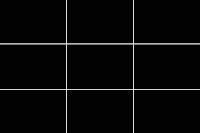
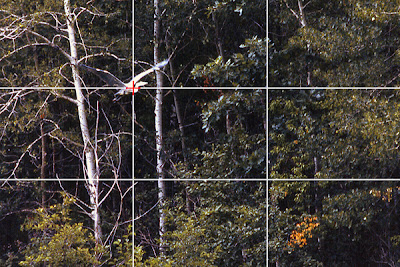
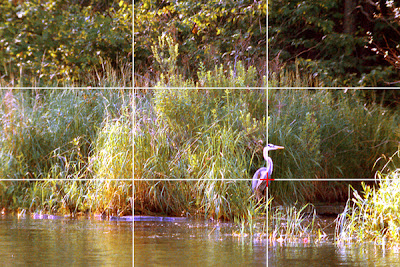
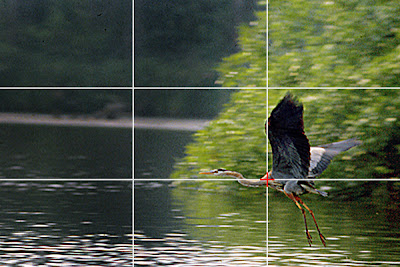
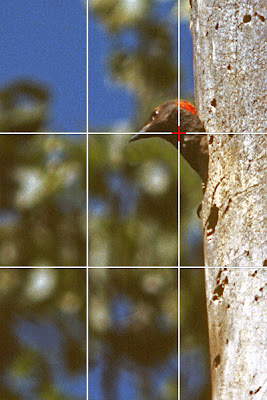
In these four examples I
used the rule of thirds by placing the main subject onto one of the four areas
where the horizontal and vertical lines intersect. Especial with cameras where the autofocus
sensor is in the center of the viewfinder, it is almost intuitive to place the
main subject in the center. That usually
has the result of the picture looking somewhat static. Applying the rule of thirds usually will lead
to a noticeable improvement of the picture.
Of course, this brings up
the question which of the four intersection point to place the subject on. In the first example, the upper left
intersection point is most advantageous in order to emphasize the height of the
flying bird. In addition, it is usually
better to place a moving subject such that it appears to be moving into the
picture, with space in front to move towards.
For the second example
there is no clear advantage of one over the other. Here it is simply a matter of what one feels
looks best.
The third example is
similar to the first one, again leaving room in front of the bird to move
towards. I chose the lower right
intersection point since the bird just took off, flying low across the surface
of the water.
The fourth example was
taken from a low vantage point, leading to an upward camera angle. Therefore the picture looks better with the
bird up high in the picture with space in front of the bird. The upper right intersecting point is the
best choice in this case.
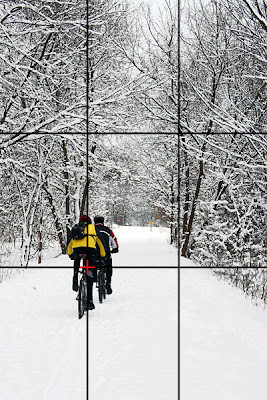
Another aspect of good
composition is lines and diagonals. They
help to lead the eye toward the subject and into the picture. The path in this photograph shows strong
lines. The main subject was best placed
on the lower left intersection point because this way the lines lead to the
impression of the bikers moving forward and into the picture.
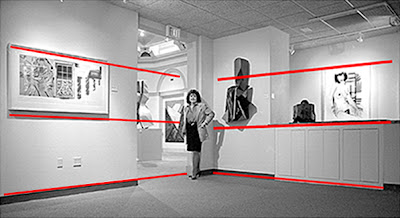
Even though placing the
subject into the center of the picture usually will lead to a static looking
image, there are times when this is actually advantageous, as in this
case. The picture contains some very
strong lines which all lead the eye toward the main subject. Utilizing these lines actually made for a
better picture by placing the subject into the center.
Another aspect of the
composition of this picture is the cropping.
Some photographs simply look better when cropped from the typical format
of the camera. The horizontal emphasis of this picture by cropping the top and the
bottom further enhance the subject position within the picture.
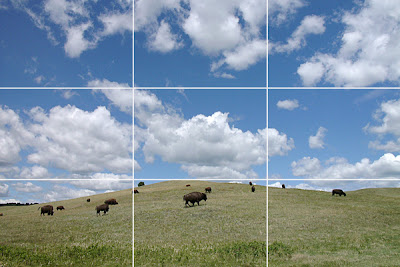
The horizontal and
vertical lines of the rule of thirds also give an indication of proper
placement of strong verticals or horizontals within the picture, like the
horizon in this case. The lower
horizontal is advantageous because it not only eliminated empty grass space in
front of the buffaloes it also allowed to take advantage of the marvelous
clouds and blue sky.
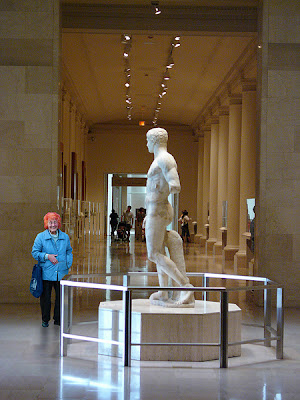
This example combines
several aspects of good composition. The
strong diagonal lines of the background lead to the main subject, the statue,
in the center. In addition, the columns
create a strong pattern which is another element of composition. Finally, the lady viewing the statue creates
a second important viewpoint of the picture.
The placement on the lower left intersecting point very much adds to the
composition, as do the strong colors in the otherwise subdued colors of the
picture, especially the bright, red hair.
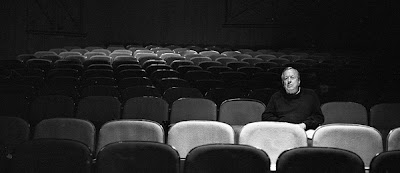
This is another example of
strong subject placement, in this case on the right vertical line. The picture would have had a lot less impact
had the subject been placed in the center.
In addition the picture is further enhanced by the cropping and the pattern
of the seats in both the foreground and especially the background.
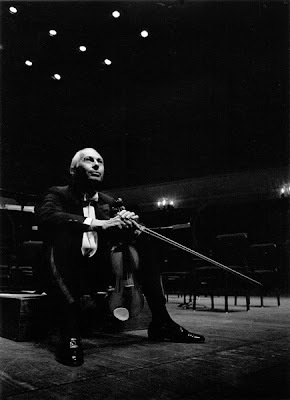
Placing the subject on the
lower left intersecting point emphasized the upward camera angle without
allowing it to appear distant as it would have been the case had it been placed
on the upper left intersection point. In
addition, the mostly black background creates a lot of so called dead
space. This is often preferable over
background detail which would be distracting.
Finally, the violin bow is a strong line, leading to the main subject of
the picture.
Color can be another important element of a photograph as in this example. While the colors are not an element of composition on their own, they have a great impact in this example by being placed prominently in the center, surrounded by the muted colors of the shadows and by creating a very strong diagonal.
Framing can be used to emphasize the main subject of a photograph. In the first example, the dark arch draws the eye immediately to the main subject, the street scene. Similarly, the trees in the second example achieve the same result.
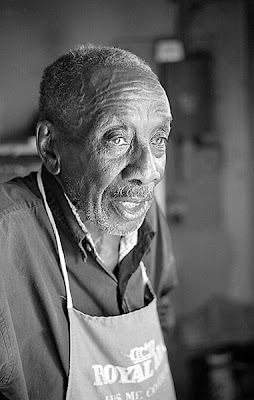
In portraits it is
generally preferable to have more space in front of the face than in back. Choosing to place the subject in the left
vertical of the rule of thirds assured proper subject placement in this case.
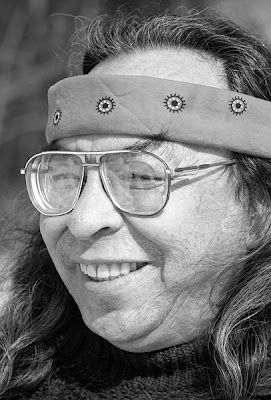
There are, however, times
when the rule of thirds does not apply, as in this case. The strong face of the person in this picture
was emphasized by the close up of it.
Since it fills the entire frame, there was no other choice than to
center it. Anything else would have been
distracting.
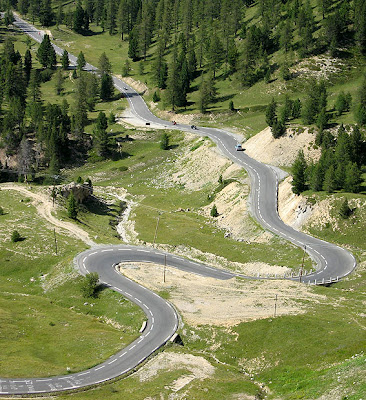
Another element of good
composition are curves or s-lines. As in
this example, they are an interesting element of the picture that helps to lead
the eye into the picture.
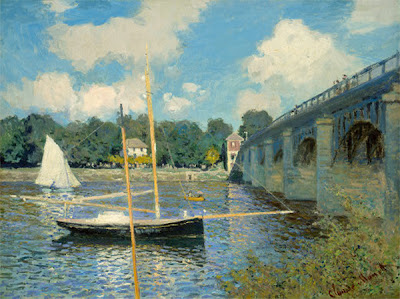
Of course, these elements
of good composition don’t apply just to photography. They have been applied by the great masters
for years, just as in this case of the painting “The Bridge At Argenteuil” by
Claude Monet. It contains numerous
elements of good composition. The
bridge shows several strong lines, including a pattern created by the upright
pillars and it also leads the eye toward the background. The sailboat in the foreground is placed in
the lower left intersection point of the rule of thirds. The mast the boom and the bow sprit of the
boat also form very strong lines. The
combination of all of these elements of good composition ultimately make for a
very interesting picture.
There are certainly
additional rules of composition. As
mentioned above, to keep this article from becoming too long and possibly too
confusing, I tried to concentrate on the most useful ones here. Applying these when possible or warranted
will lead to better pictures and over time, photographers will get used to it to
the extent that these rules and their application will become second
nature. At that point, we have bridged
the difference between just taking pictures and creating photographs.
________________________________________________________________________________________
To comment or to read comments please scroll past the ads below.
All ads present items of interest to Leica owners.


To comment or to read comments please scroll past the ads below.


All ads present items of interest to Leica owners.



For more information on KOMARU and for orders go to: www.taos-photographic.com
NEW Komaru Colors
For more information and pre orders go to: www.lenstab.com
For more information on KOMARU and for orders go to: www.taos-photographic.com
NEW Komaru Colors
For more information and pre orders go to: www.lenstab.com
Click on image to enlarge
Order: info@gmpphoto.com
Click on image to enlarge
Order: info@gmpphoto.com
Click on image to enlarge
Order: info@gmpphoto.com
Click on image to enlarge
Order: info@gmpphoto.com
Please make payment via PayPal to GMP Photography
Click on image to enlarge
Order: info@gmpphoto.com
Please make payment via PayPal to GMP Photography
Click on image to enlarge
Order: info@gmpphoto.com
Please make payment via PayPal to GMP Photography















Thank you for posting this. I will try to make use of it in the future.
ReplyDeleteIn the second picture from the top, wouldn't the bird have been better placed on the lower left intersection point? That way there would have been more space in front than in back of the bird.
ReplyDeleteBasically you are correct, however, I do think this particular picture would look just fine with the bird on any of the intersection points. However, I do recall some ugly debris in the water to the right of the picture. This is the reason why I placed the bird the way I did.
DeleteIn this regard the viewfinder of the Leica M cameras has a definite advantage over DSLR cameras because it always shows items beyond what the lens is recording. That makes subject placement often substantially easier. It has happened many times that I discovered additional items that would look good if visible on the picture, items that in most cases would have been lost with DSLRs.
This post is a really good discussion of the rule of thirds. Very good piece.
ReplyDeleteThank you. I consider the rule of thirds probably the most useful of all the compositional rules since it covers so many aspects of a picture.
ReplyDelete